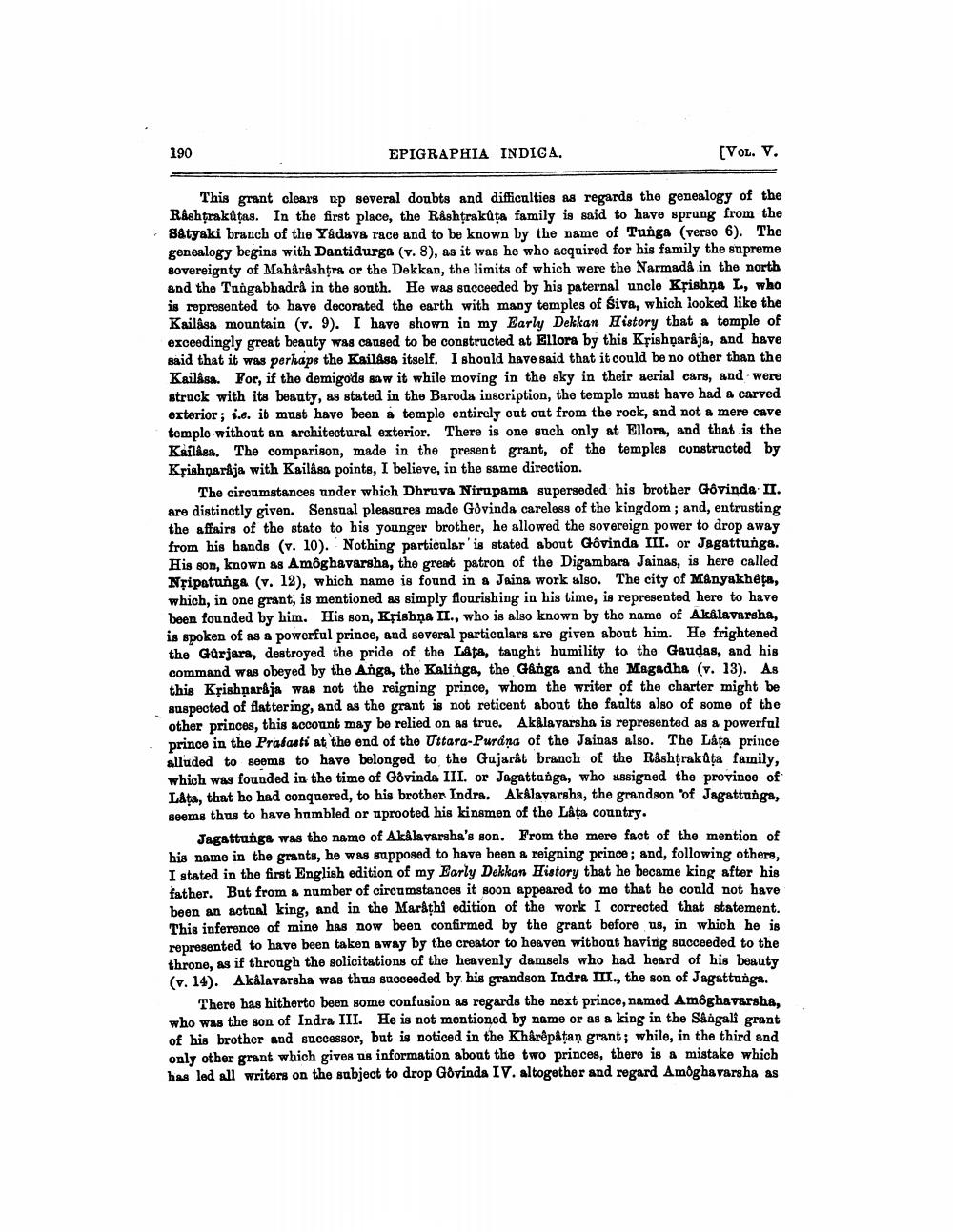________________
190
EPIGRAPHIA INDICA.
(VOL. V.
This grant clears up several doubts and difficulties as regards the genealogy of the Rashtrakūtas. In the first place, the Rashtrakůta family is said to have sprang from the Satyaki branch of the Y&dsve race and to be known by the name of Tunga (verse 6). The genealogy begins with Dantidurga (v. 8), as it was he who acquired for his family the supreme sovereignty of Maharashtra or the Dekkan, the limits of which were the Narmada in the north and the Tungabhadra in the south. He was succeeded by his paternal uncle Krishna I., who is represented to have decorated the earth with many temples of Siva, which looked like the Kailasa mountain (v. 9). I have shown in my Early Dekkan History that a temple of exceedingly great beauty was caused to be constructed at Ellora by this Krishọarâja, and have said that it was perhaps the Kailasa itself. I should have said that it could be no other than the Kailasa. For, if the demigods saw it while moving in the sky in their aerial cars, and were struck with its beauty, as stated in the Baroda inscription, the temple must have had a carved exterior ; i.e. it must have been a temple entirely cut out from the rock, and not a mere cave temple without an architectural exterior. There is one such only at Ellora, and that is the Kailasa. The comparison, made in the present grant, of the temples constructed by Krishṇarija with Kailasa points, I believe, in the same direction.
The circumstances under which Dhruva Nirupama superseded his brother Govinda II. are distinctly given. Sensual pleasures made Gôvinda careless of the kingdom; and, entrusting the affairs of the stato to his younger brother, he allowed the sovereign power to drop away from his hands (v. 10). Nothing particular' is stated about Gôvinda III. or Jagattunga. His son, known as Amoghavarsha, the great patron of the Digambara Jainas, is here called Nřipatunga (v. 12), which name is found in a Jaina work also. The city of Mânyakheta, which, in one grant, is mentioned as simply flourishing in his time, is represented here to have been founded by him. His son, Krishna II., who is also known by the name of AkÁlavarsha, is spoken of as a powerful prince, and several particulars are given about him. He frightened the Gürjara, destroyed the pride of the Låte, taught humility to the Gaudas, and his command was obeyed by the Anga, the Kalinga, the Ganga and the Magadha (v. 13). As this Krishộar&ja was not the reigning prince, whom the writer of the charter might be suspected of flattering, and as the grant is not reticent about the faults also of some of the other princes, this account may be relied on as true. Akalavarsha is represented as a powerful prince in the Prabanti at the end of the Uttara-Purdna of the Jainas also. The Lâta prince alluded to seems to have belonged to the Gujarat branch of the Rashtrakata family, which was founded in the time of Govinda III. or Jagattunga, who assigned the province of Lata, that he had conquered, to his brother Indra. Akalavarsha, the grandson of Jagattunga, seems thus to have humbled or aprooted his kinsmen of the Laţa country.
Jagattunga was the name of Akalavarsha's son. From the mere fact of the mention of his name in the grants, he was supposed to have been a reigning prince; and, following others. I stated in the first English edition of my Early Dekkan History that he became king after his father. But from a number of circumstances it soon appeared to me that he could not have been an actual king, and in the Marathi edition of the work I corrected that statement. This inference of mine has now been confirmed by the grant before us, in which he is represented to have been taken away by the creator to heaven without having succeeded to the throne, as if through the solicitations of the heavenly damsels who had heard of his beauty (v. 14). Akálavarsha was thus succeeded by his grandson Indra III., the son of Jagattunga.
There has hitherto been some confusion as regards the next prince, named Amoghavarsha, who was the son of Indra III. He is not mentioned by name or as a king in the Sangali grant of his brother and successor, but is noticed in the Khårêpatan grant; while, in the third and only other grant which gives us information about the two princes, there is a mistake which has led all writers on the subject to drop Govinda IV. altogether and regard Amoghavarsha as




